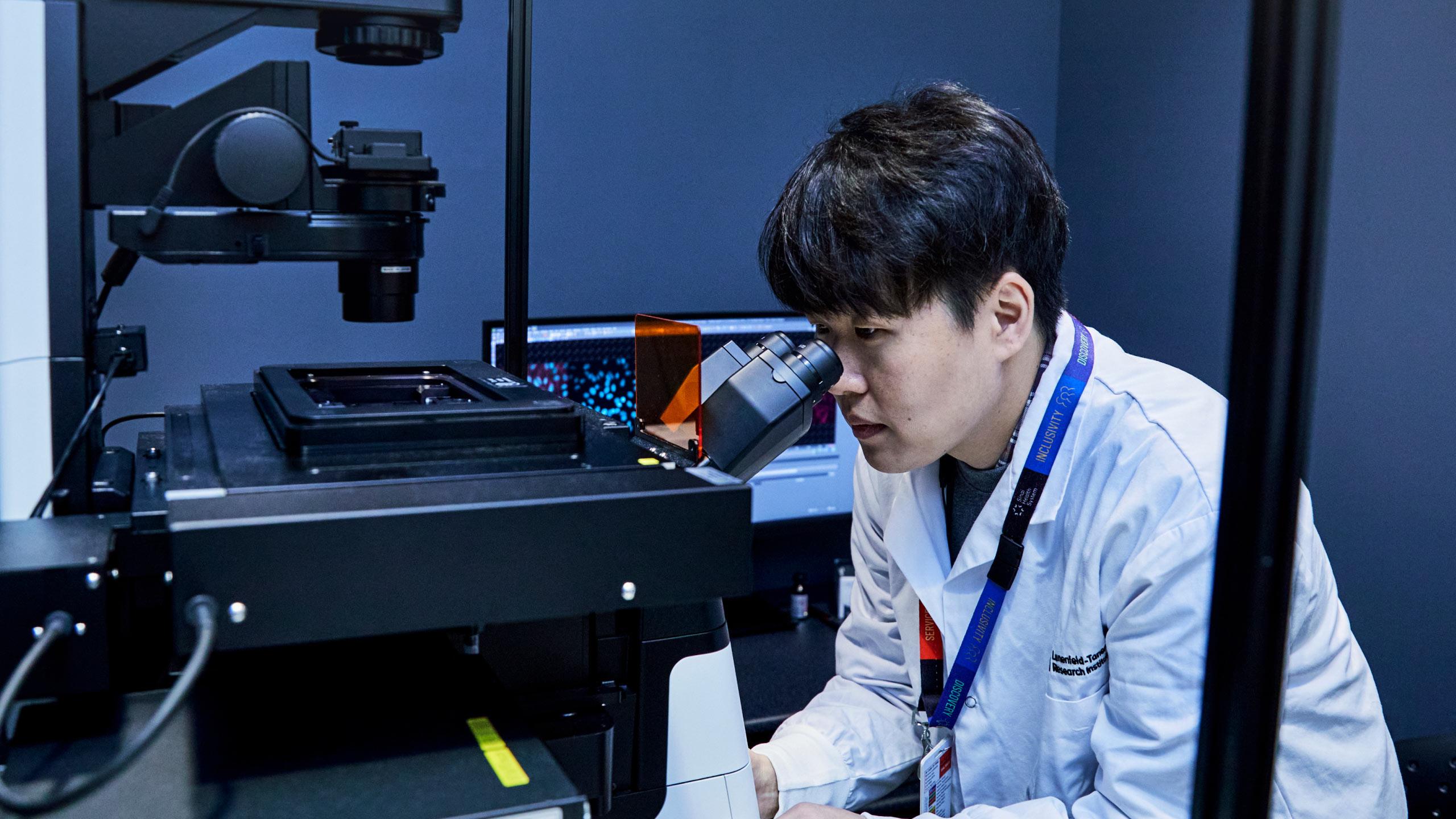Breast Imaging
Breast imaging helps detect and diagnose changes or abnormalities in the breast.
What we do
Our department offers the following types of breast imaging:
- Mammograms (including contrast-enhanced mammography)
- Breast ultrasound
- Interventional procedures, such as ductogram/galactogram, breast biopsy (including ultrasound core biopsy, stereotactic core biopsy and fine needle aspiration biopsy) and contrast-enhanced digital mammography biopsies
- Tomosynthesis, which is a type of mammogram that produces 3D images of the inside of your breasts
The Marvelle Koffler Breast Centre at Mount Sinai Hospital was the first centre in North America to use digital mammography. Our radiologists work across all locations of the Joint Department of Medical Imaging, ensuring you receive the same quality of care at any of our breast imaging sites.
The Marvelle Koffler Breast Centre is an Ontario breast screening program site. Learn more about breast screening and who is eligible.
What to expect
Before your appointment
Please arrive 15 minutes before your appointment. If you are late, your appointment may be rescheduled.
Avoid wearing perfumes or using heavily-scented products. We are a scent-sensitive environment. Do not wear jewelry and do not apply any powder, lotions or deodorants on the day of the test, as they can impact results.
Please do wear two-piece clothing as you will be asked to undress from the waist up.
Bring (or send in advance) any previous mammogram exams done at another facility. If you wish to have another doctor copied on the results report, please let the receptionist know before your test.
At your appointment
The time you spend at your appointment will vary depending on the type of imaging test you are having.
For example, mammograms and ultrasounds can take about one hour or longer, depending on the complexity of the exam.
Ductograms, biopsies and pre-operative needle localizations usually range from 45 to 60 minutes.
After a biopsy, you may need to stay an extra 15 minutes for observation.
Our team tries to stay on time, but your appointment may be delayed by unforeseen circumstances. It is a good idea to be prepared in case your appointment runs late.
We will give you a hospital gown to wear during the procedure.
After your appointment
Breast imaging reports are sent to physicians with 10 days.
If you had a biopsy, we will give you instructions on how to take care of yourself after the biopsy. It can take a bit longer than 10 days to process biopsy results.
Your referring physician will contact you when the results are ready.
What to bring
- Health (OHIP) card or valid health-care coverage
- Any previous mammogram reports (if not sent ahead of time)
- Wear two-piece clothing
How to access our services
You need a referral from a health-care provider to be seen at medical imaging. Visit our referral criteria for more information.
If you qualify for the Ontario Breast Screening Program as average risk (ages 40-74), you can self-refer for a screening mammogram. Please see eligibility criteria for the program. Screening mammograms can be booked by calling: 416-586-4800 ext. 4422.
Department of Medical Imaging
600 University Avenue
12th floor
See maps, directions and parking for Mount Sinai Hospital.
Phone: 416-586-4800 ext. 4422
Fax: 416-586-4714
Monday to Friday
8 a.m. to 4:30 p.m.
Types of breast imaging procedures
Mammogram
A mammogram is a digital X-ray of breast tissue. It can give physicians information about lumps, calcifications and other abnormalities that may be present in the breast. Mammograms are also used to screen for breast cancer.
During your mammogram you will stand in front of the X-ray machine with your breasts resting on a plate. The technologist will gently but firmly compress your breasts between two plates for a short time during the exam. This might feel uncomfortable, but it is necessary to get clear pictures and keep the radiation dose low.
If you can, it is a good idea to schedule your mammogram about two weeks after your period has ended.
Before the procedure starts, let the technologist know if you:
- Are pregnant or might be pregnant
- Have any implanted devices like a pacemaker or port
- Have any shoulder or other mobility issues
- Have any skin conditions
Mammography, which is the process of doing a mammogram, is accredited by the Canadian Association of Radiologists.
Breast ultrasound
A breast ultrasound uses sound waves to create a picture of the breast. It can show areas of the breast that are hard to see in a regular mammogram, like the areas closest to the chest. This helps physicians get more information about lesions, lumps or masses that were found on a mammogram or felt during an exam.
During your ultrasound, you will lie on your back on the examination table with your arm raised above your head. The technologist will apply a water-based gel on your breast and then press the ultrasound probe firmly against the skin and glide it over the area of interest several times to get a good look.
Ductogram (galactogram)
This procedure is done when someone has fluid (discharge) coming out of their breast in order to figure out which duct the discharge is coming from.
Before the procedure, we might use a warm towel on your breast to help get the fluid flowing.
If the radiologist can see where the fluid is coming from, they will put a thin, flexible tube called a blunt-tipped cannula into the duct. Then, they will inject a small amount of contrast dye into the duct through the cannula. You might feel some pressure or fullness when the dye is injected.
After that, the technologist will take some mammogram pictures of the ducts.
Once the procedure is done, you can go back to your normal activities.
Breast biopsy
A breast biopsy is a procedure to remove a small amount of breast tissue for testing. It is done when something suspicious shows up on a mammogram and your physician wants to know more about it.
Here are some important things to keep in mind:
- If you are taking blood thinners (anti-coagulants), please talk to your physician before your appointment. Depending on the medication, they might need to check your blood’s clotting ability beforehand. A recent international normalized ratio (INR) test may be needed and should be provided by the referring physician in advance of your scheduled appointment.
- Let your physician know if you have any concerns or known allergies to local anesthetic before your biopsy.
- Please arrange to have a support person accompany you home after the biopsy. A post procedure care sheet with instructions on how to take care of yourself after the biopsy will be given to you afterwards.
There are different methods used for doing biopsies, including the following.
Stereotactic core biopsy
A stereotactic core biopsy is used to obtain breast tissue when small calcium deposits are seen on a mammogram.
During the procedure, you will either sit or lie on your side with your breast compressed between two flat plates. The radiologist will make you as comfortable as possible since it is very important that you stay still during the procedure.
The radiologist will numb the area to be biopsied with a local anesthetic. Several tissue samples will be taken and then x-rayed to see if they contain calcifications. A mammogram will also be done during the procedure.
At the end, the radiologist may place a clip in the biopsy site for future reference if necessary.
Ultrasound-guided core biopsy
In an ultrasound-guided core biopsy, a physician inserts a needle in an area in the breast through a small cut in the skin to obtain tissue samples.
You will first get some numbing medicine on the area (local anesthetic), and then the physician will take the samples.
Core biopsy is performed using a device that makes a loud clicking noise or using a vacuum assisted device.
You may feel some discomfort or pressure during the biopsy.
At the end, the radiologist may place a clip in the biopsy site for future reference if necessary.
Fine needle aspiration biopsy
A fine needle aspiration biopsy uses ultrasound and a thin needle to collect fluid or cells from the breast or lymph node. The sample is analyzed under a microscope to give a more accurate diagnosis.
You will be asked to lie on your back on the examination table, as you would for a regular breast ultrasound. The radiologist will find the spot of interest and numb it with a local anesthetic. Once the areas is numb, the radiologist will use a fine needle to collect cell samples.
Digital breast tomosynthesis (DBT)
Digital breast tomosynthesis (DBT) is a high-tech version of a mammogram. Instead of just one picture, it takes multiple images of your breast from different angles to make a 3D image.
DBT can be useful in many cases, especially if you have dense breast tissue that can make it difficult to identify cancer on a standard two-dimensional mammogram.







